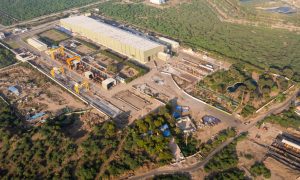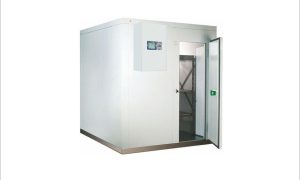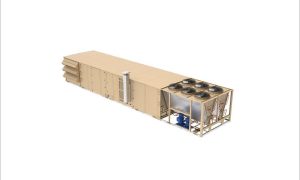Vikas Choudaha discusses Godrej’s comprehensive solutions for intra-logistics and cold chain applications. He discusses that online platforms have impacted the frozen food industry, leading to adopting a multi-tiered operational structure and the need for advanced temperature control and refrigerated trucks.
What are some key insights regarding the growth and demand in the cold chain sector, specifically in warehousing and logistics?
Customers strongly desire to streamline their warehousing operations, particularly in cold chains. Within the cold storage sector, there are two distinct segments. The first consists of traditional cold stores used for commodities such as potatoes. However, there is a growing potential for cold chain, logistics, and warehousing in the food industry, particularly in seafood, meat, and poultry.
The second aspect relates to specific regions where the demand for cold storage is seasonal. In the northern part of India, for instance, apple growers require temporary cold storage facilities during the harvest period. Establishing and maintaining cold storage for such short durations can be challenging. Nevertheless, this is an exciting time for the growth of warehousing and logistics, as the cold chain sector, including both warehousing and logistics, is experiencing a significant surge in demand.
What strategies are employed to optimise the cold chain process and reduce warehouse refrigeration load?
There is a strong emphasis on optimising the cold chain process for perishable goods, encompassing storage, logistics, and transshipment points. Inadequate handling during transportation or at intermediate points in the supply chain can lead to wastage. Therefore, there is a growing focus on using large-sized trucks to ensure proper care during transit, even though it is a relatively short duration. However, these products spend a large amount of time in warehouses. As a result, companies are actively seeking ways to insulate their warehouses with double walls to reduce refrigeration load. Instead of creating separate cold rooms within the warehouse, the goal is to construct the entire warehouse to reduce the refrigeration load one approach being explored is the construction of taller warehouses, which helps the heat load and makes refrigeration more efficient.
What key aspects and technologies drive automation in sub-zero environments within the warehousing industry? Automation technology in sub-zero warehousing environments is primarily driven by the challenges associated with human presence in harsh conditions. Implementing automated systems helps minimise or eliminate the need for human intervention. Centralised mobile racking systems, where racks can collapse to open one aisle at a time, optimise storage density. These systems can now be remotely controlled for operations.
Automated storage and retrieval systems enable precise temperature control, with most storage operations occurring in the back end while human operators handle inbound and outbound areas. Control and management systems with advanced inventory management capabilities facilitate efficient movement based on the first-in, first-out (FIFO) principle, ensuring inventory status and movement visibility.
Integration of warehouses with manufacturing or the supply side is increasingly essential to eliminate inefficiencies. Seamless integration and automation are pursued from the processing area to storage, utilising conveyors and other automation technologies. Expanding Automated Storage and Retrieval Systems (ASRS) to include Automated Guided Vehicles (AGVs) and Autonomous Mobile Robots (AMRs) allows efficient movement within the cold storage area and between operational zones and storage facilities.
What are the benefits and applications of mobile racking systems in temperature-controlled warehouses?
Mobile racking systems are utilised in temperature-controlled warehouses in moderate and sub-zero environments. The milk, dairy and pharmaceutical industries have embraced this technology due to its numerous benefits.
Unlike traditional fixed rack systems with multiple aisles, mobile racking systems offer higher storage density within a given space. The entire system can be shifted by placing racks on movable bases, reducing required space and optimising storage capacity. This also leads to energy efficiency, with mobile racking systems consuming half the energy compared to fixed systems, resulting in cost savings and environmental advantages. Mobile racking systems can be customised based on client preferences, offering manual, semi-automated, and fully integrated options with warehouse management capabilities. The integration allows for inventory management and equipment retrieval based on system indications. Additionally, there are manual configurations available for clients prioritising storage density without extensive electronic integration or compatibility with warehouse management systems.
What are the key factors driving growth in the integration of warehousing and logistics in India?
The integration of warehousing and logistics can be divided into manufacturing logistics and pure distribution. There is growth in the manufacturing sector as companies aim to optimise their factory attached warehouses. In the distribution sector, e-commerce investments have driven infrastructure development for direct shipping to customers.
There is a focus on optimising the existing infrastructure in the warehousing sector following the establishment of significant infrastructure in recent times. While short-term growth may be slightly subdued in the next three to nine months, the long-term growth potential remains promising. Three key factors are driving this growth. Firstly, the overall growth and consumption levels in the country remain unaffected. This has led to the development of larger volume format warehouses, consolidation of multiple warehouses into a single facility, and the transition towards more organised and taller warehouses. Secondly, the consumption patterns in India are expanding beyond big cities and towns, with increasing demand and aspirations in tier two and tier three towns. This demand is driven by both large corporations and smaller businesses operating in these areas.
The absorption rates of the warehousing in the manufacturing sector is showing good growth, particularly in regions impacted by government initiatives like the Production Linked Incentive (PLI) scheme. Infrastructure improvements and establishing multimodal logistics parks enhance logistics efficiency and present opportunities for large-scale warehousing facilities. While a slight slowdown may occur in the short term, the industry remains positioned for growth.

How is temperature control achieved in taller temperature-controlled warehouses?
Maintaining a consistent temperature throughout the storage space has been the conventional practice in temperature-controlled warehouses. However, in taller warehouses, a more sophisticated approach is employed. Sensors strategically placed across the storage rack systems enable temperature mapping of the entire warehouse. The air conditioning or refrigeration system uses this data to ensure uniform temperature distribution and prevent localised hot spots or variations. Ducts running through the rack systems further enhance temperature control. This approach combines science and effective management to optimise temperature control while benefiting from reduced air conditioning load in taller warehouses.
What role should the industry play in seizing opportunities and addressing issues in the cold chain sector?
While the government has implemented various schemes and subsidies to support the development of infrastructure in the cold chain sector, there is a need for the industry to take a proactive role in seizing opportunities and addressing issues such as waste reduction. Although there may be some initial capital expenditure involved, businesses must recognise the long-term benefits and invest in the necessary infrastructure. Certain regions, particularly coastal areas, have already responded positively to these solutions, with successful adoption by forward-thinking entrepreneurs and associations. Encouraging more such businesses to embrace these advancements will drive the modernisation and organisation of cold chain warehousing and logistics.
What divisions does Godrej have within the company, and what solutions do they offer for intra-logistics and cold chain applications?
Godrej offers a comprehensive range of warehousing solutions, focusing on intralogistics within the facility rather than logistics beyond it. They have three divisions within the company:
- The storage group, which specialises in providing various storage systems.
- The material handling business offers electric warehousing trucks and equipment for efficient goods movement.
- The joint venture company Godrej Koerber delivers automated solutions to the market.
As a company, Godrej can provide complete solutions for intra-logistics, including storage, handling, and cold chain applications. However, it’s important to note that there are technical considerations when transitioning from ambient to controlled temperatures, especially when working in sub-zero conditions. Factors such as component selection, steel quality, and condensation management become crucial. Careful design is necessary to ensure proper service access and the choice of appropriate components, particularly for metals and electronics, such as motors and electronic systems.
What are the key observations regarding the impact of online platforms on the frozen food industry, and what operational structure are companies adopting in response to this?
It is fascinating to observe the impact of online platforms on the frozen food industry, particularly on meat and poultry products. Companies are adopting a multi-tiered operational structure, which involves establishing large distribution hubs and smaller temperature-controlled warehouses within cities. This presents two distinct opportunities: the need for larger distribution centres with advanced temperature control capabilities and the requirement for smaller, accessible warehouses with efficient retrieval systems. Additionally, the ability to ensure temperature-controlled logistics throughout the entire supply chain becomes crucial.
Refrigerated trucks play a vital role in transporting goods from distribution centres to smaller warehouses or directly to customers’ homes. Insulated boxes or similar equipment are necessary to ensure product quality during the last mile of delivery. Validation methods, leveraging technologies like IoT, can provide transparent visibility of temperature control throughout the journey to guarantee product integrity.
The experience gained from handling vaccine logistics during the pandemic can be applied to ensure validation and temperature control throughout the supply chain. Establishing methods and processes to maintain the integrity of the cold chain and provide transparent visibility to customers is essential.
How does our company contribute to the growth of the warehousing and logistics industry, particularly in the cold storage sector?
We actively contribute to the growth of the warehousing and logistics industry, particularly in the cold storage sector. By partnering with experts and consultants, we create purpose-built solutions for cold store warehouses, prioritising storage and handling. We prepare to meet high demand during peak seasons in regions like North India. Recently, we organised a meeting with apple growers in Jammu and Kashmir, aiming to replicate this approach in other specific regions. Our commitment to automation extends to handling both heavier palletised and lighter goods. For example, we secured an opportunity to automate the movement and storage of crates for a milk-producing company using a mobile racking system. Our comprehensive range of solutions makes us well-prepared to meet diverse customer needs.
We strongly believe in collaborating with clients through our “customer immersion” program. This involves deep engagement to understand their specific context and develop tailor-made solutions. By involving clients and their teams, we ensure better adoption and create a sense of ownership for the clients. We actively engage with customers at the organisational level and provide personalised immersion experiences. With the industry’s support and overall economic growth, we are optimistic about our strategies and believe we will continue to thrive.
Cookie Consent
We use cookies to personalize your experience. By continuing to visit this website you agree to our Terms & Conditions, Privacy Policy and Cookie Policy.















